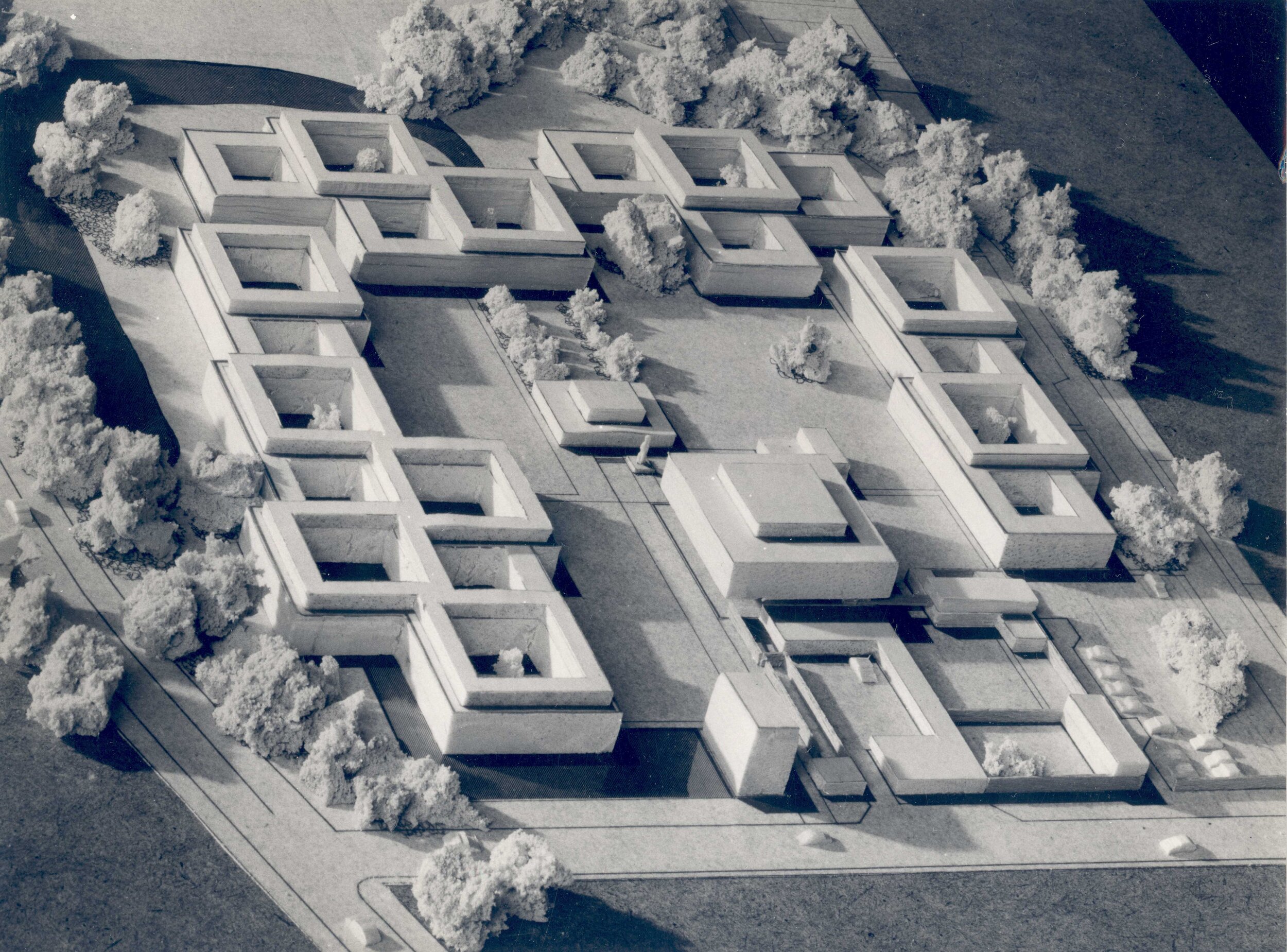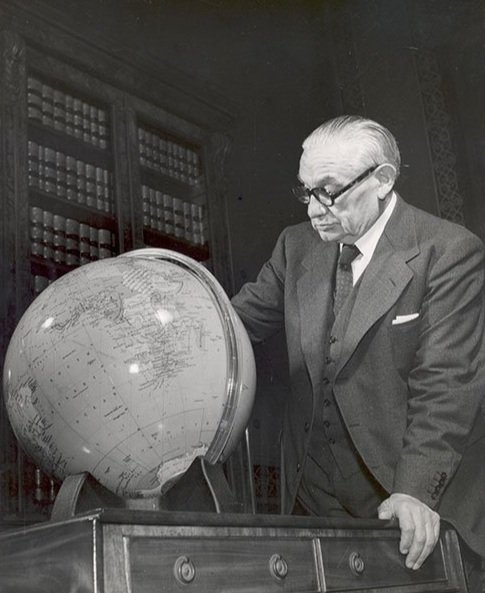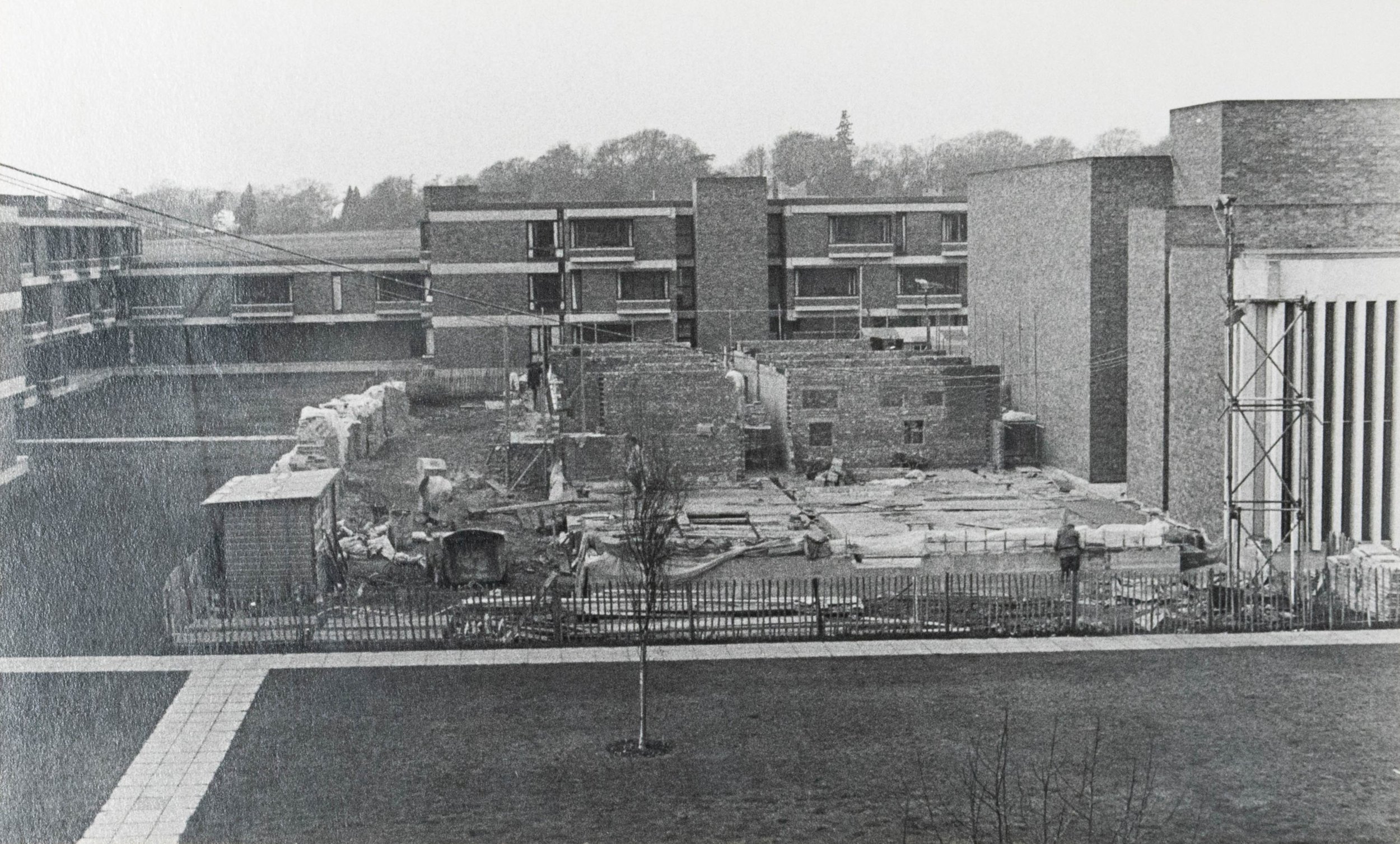
Celebrating the 50th Anniversary of
Churchill Archives Centre
In this online exhibition, we explore the people and events that have shaped our history.
1963
‘I suppose the College does realise that Sir Winston’s papers are likely to come to it one day?’
When Churchill College was founded in 1960, it was built as the National and Commonwealth memorial to Sir Winston Churchill. The founders of this new Cambridge college envisioned it to be ‘a bridge between the achievements of the past and the possibilities of the future’. That being said, the idea of an archive, at the heart of college, perhaps unsurprisingly wasn’t in the minds of the Founding Fellows.
On a cold January evening in 1963, three years after the College had opened, it was in Cambridge’s largest college dining hall that the seed for the Archives Centre was planted. Over a High Table dinner, Anthony Montague Browne, Sir Winston Churchill’s Private Secretary innocently asked Senior Research Fellow, Captain Stephen Roskill, ‘I suppose the College does realise that Sir Winston’s papers are likely to come to it one day?’ The short answer was - no.
Architects' models for the design of Churchill College, CCPH 5/1.
Browne had clearly piqued Roskill’s enthusiasm. In a letter to Browne, Roskill wrote how the idea of an archive was ‘immensely attractive’. However, turning the idea of an archive into a reality was no easy task. Whose papers would it collect? Who would make the connections with potential depositors? And where would a physical archive fit on the existing College site? These were just some of the questions which needed to be answered over the next two decades.
In 1965, Roskill, joined by Sir John (“Jock”) Colville (former private secretary to Sir Winston and a trustee of the College), and Sir John Cockcroft (Nobel Prize-winning physicist and Churchill College Master), put their networks to good use. They sounded out whether their fellow prominent politicians, soldiers, and scientists might have papers that they’d like to give to a brand new archive. The answer was a resounding yes.
The first collection to arrive at Churchill College was a small collection of papers belonging to Clement Attlee. These papers were shortly followed by those belonging to Admiral De Robeck, politicians such as Ernest Bevin, physicist Lise Meitner, Nobel prize-winning physiologist A V Hill, civil servant Maurice Hankey, and courtier Lord Esher.
In just a few years, Roskill, Colville, and Cockcroft had laid the foundations for a collecting policy which would later expand as the Archives Centre developed. By 1969, the Archives Centre had received over 100 accessions.
Lise Meitner and Otto Hahn in a laboratory at Emil Fischer’s Chemistry Institute in Berlin in1909, MTNR 8/4/1.
Nobel prize-winning physiologist A V Hill in 1977.
Ernest Bevin, BEVN II 10/4.
1969
‘I received a phone call […] inviting me to become Librarian with a view to constructing an Archives Centre.’
A new collection
While the papers of those relating to the Churchill-era began to fill the library’s bookstore, none of Winston Churchill’s papers had arrived at the College. Instead, they were being pored over by Randolph Churchill and Martin Gilbert (Randolph’s successor), who were writing a multi-volume biography of Winston Churchill. As they began to wind up their research, it was Clementine Churchill who, in 1969, donated 80 boxes of her husband’s post-1945 collections to Churchill College.
Image: Clementine and Winston Churchill posing on the steps of an Imperial Airways flight to Paris, c.1934, CSCT 5/4/99.
A new librarian
In the 1960s, John Killen, Churchill College librarian, had laid the groundwork for the development of an Archives Centre building. In 1968 he worked with colleagues to write a document setting out the requirements in terms of spaces for storage, offices, conservation and exhibitions. This document would be a vital blueprint in shaping what the Archives Centre would look like.
In 1969, Michael Hoskin took over from Killen as Churchill College librarian. After recognising the pace at which the Archive Centre was expanding, the Master tasked Hoskin, a historian of astronomy, with the mission of constructing an Archives Centre. Hoskin felt it was vital for this new building to be at the heart of the College’s site.
Hoskin worked closely with Sir Jock Colville to turn this vision into a reality. Colville played a crucial role in acquiring the funding for such an endeavour. He persuaded former American ambassadors, amongst many others, to donate money for the building. Today, their names adorn the wall of the Jock Colville Hall.
Image: Michael Hoskin.
A new conservationist
It soon became clear that the College needed a Conservationist (known today as a conservator) to care for the invaluable collections arriving at the college. In 1969, Vic Brown arrived from Reading University Library Bindery to work as the college’s first Conservator. In the photograph opposite, you can see him working in a large second floor room, which we still use today as the Conservation studio.
Image: Vic Brown working in the conservation studio at Churchill Archives Centre, CCAR 907/5 pt 2.
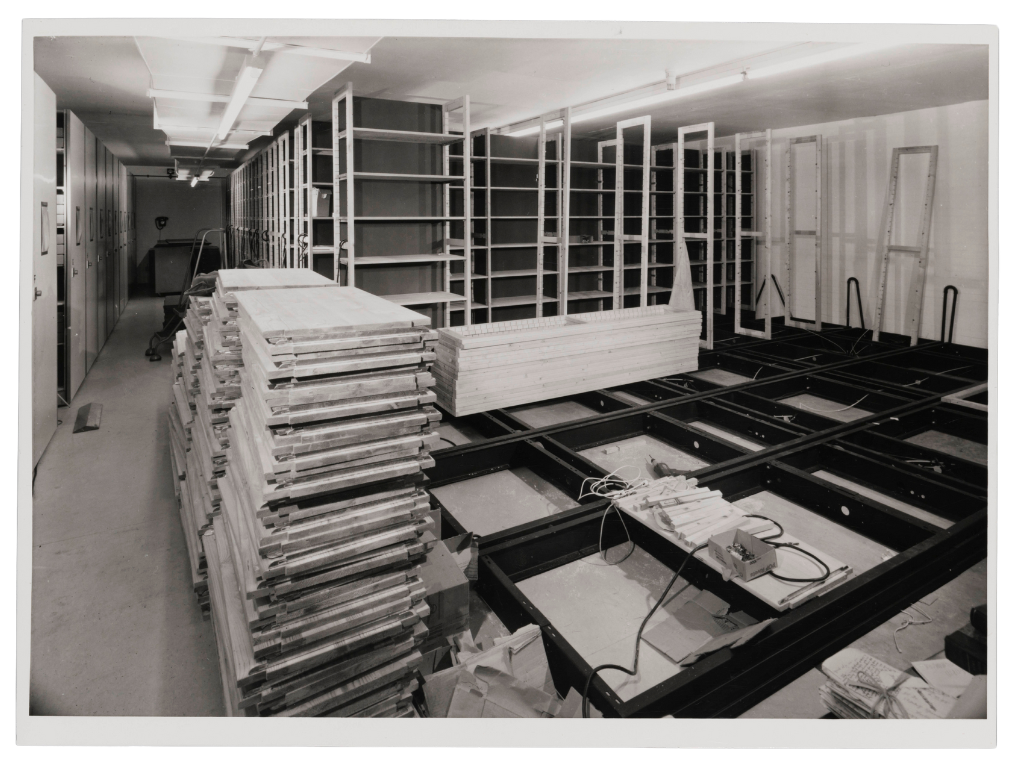
The building of the shelves in the Archives Centre Strong Room, CCPH 5/8/1, © Lafayette Photography Ltd.

The construction of Churchill Archives Centre in December 1971, ROSK 18/7.
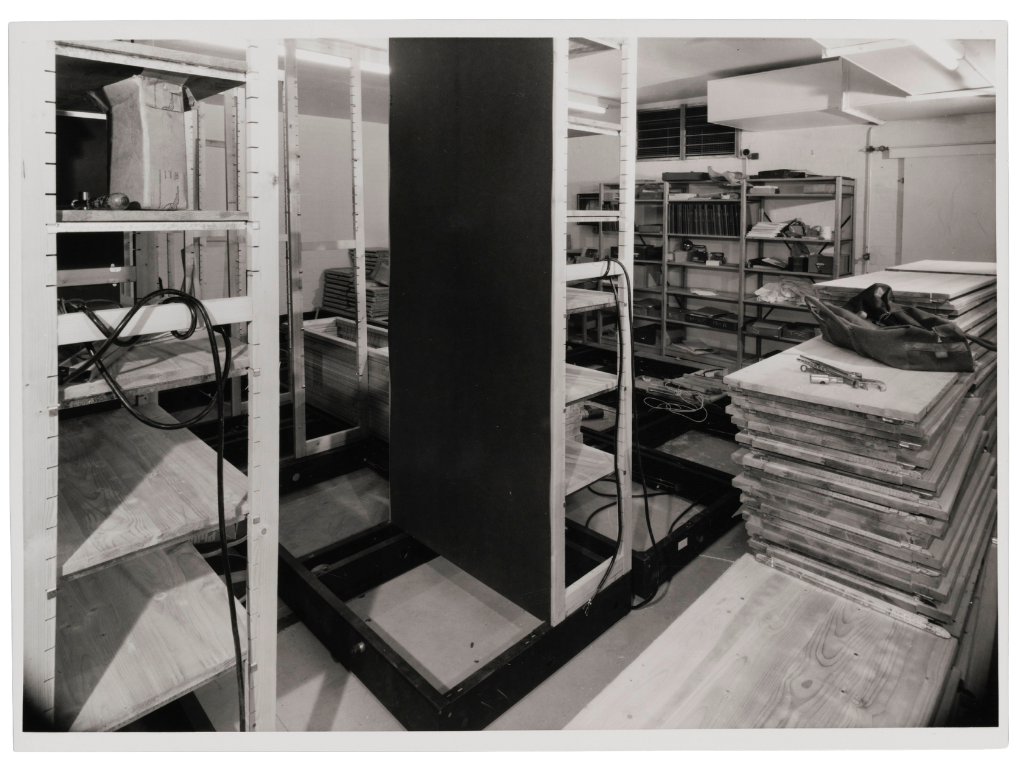
The building of the shelves in the Archives Centre Strong Room, CCPH 5/8/1, © Lafayette Photography Ltd.
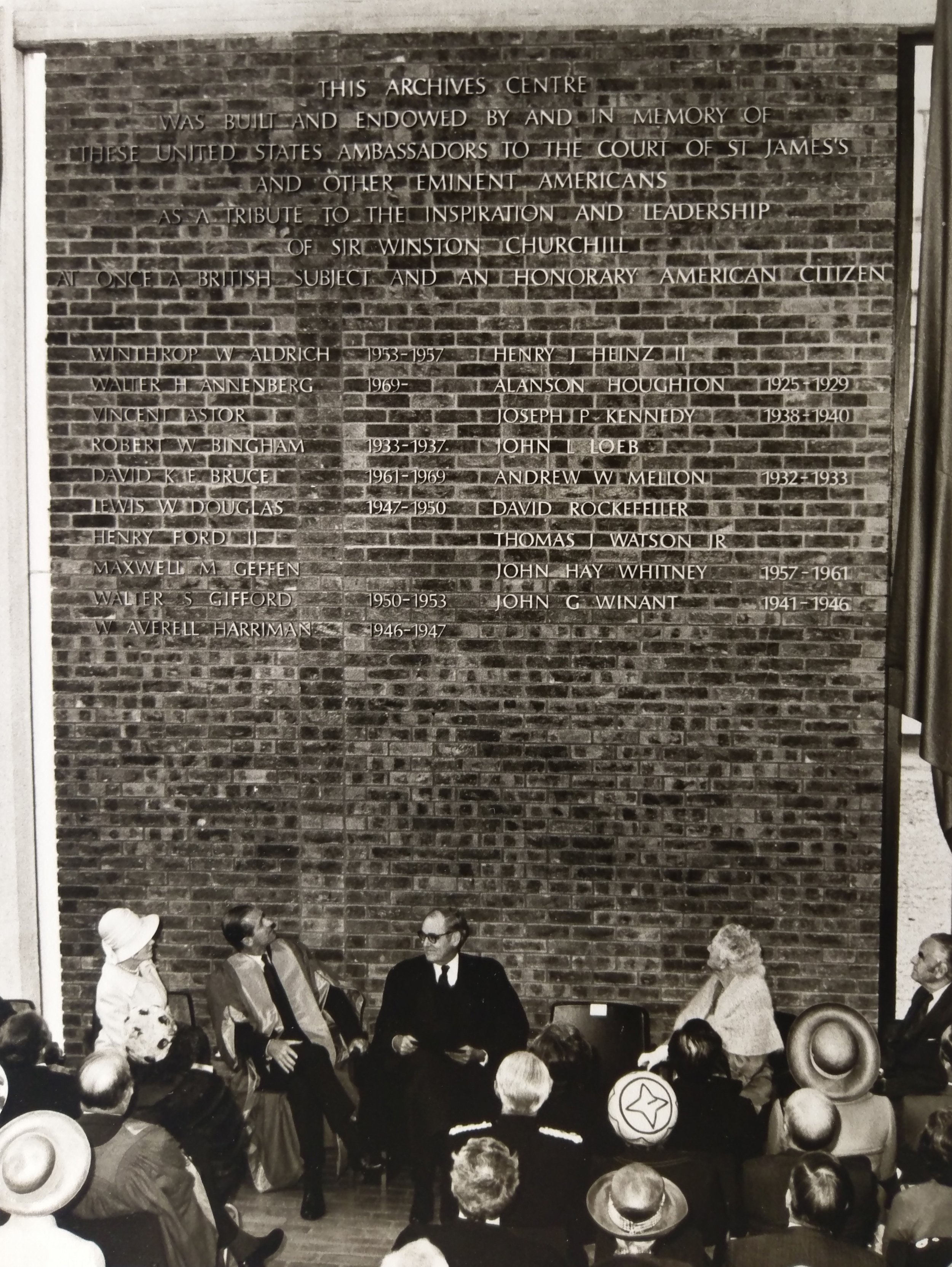
1973
The Opening of Churchill Archives Centre
From left to right, top to bottom:
Invitation to the Opening of the Archives Centre, CCAR/907; The front cover and inside page of the programme, ROSK 18/7; A photograph of the Duke of Edinburgh, Mr Averell Harriman, American Ambassador to Britain in 1946, and Clementine Churchill sat in what was then known as the Exhibition Hall underneath a list of the American ambassadors who had helped to fund the building, CCPH 4/7; A photograph of the Duke of Edinburgh walking towards the new Archives Centre, CCPH 4/7; A photograph of Mr Averell Harriman giving a speech as part of the opening, CCPH 4/7.
On 26 July 1973, Churchill Archives Centre opened to a considerable fanfare - literally. As the trumpeter’s music filled the newly-built hall, Walter H. Annenberg, the United States Ambassador, performed the opening in the presence of HRH Prince Philip and with Lady (Clementine) Churchill in attendance.
Hywel George, Churchill College Bursar, remembers how:
‘There was a very formal lunch at which the Master, who of course had to give the usual toasts, including on this occasion a toast to the President of the United States, because it was very much an American concern. The American Overseas Fellows at the time were opposed to this because they were, well, Nixon was President, and they were all very anti-Nixon, so they, I understand, unofficially decided that they wouldn’t stand when the toast was given. So, Will Hawthorne had to find a way of getting around this and he managed very well. He got to his feet with the usual toast to the Queen, Churchill and without breaking, the President of the United States. It was all done while they were all on their feet for a toast to Churchill and the Queen and so that no one sat down. So that passed very well.’
You can listen to more of Hywel’s memories of the opening in this short extract from his oral history below.
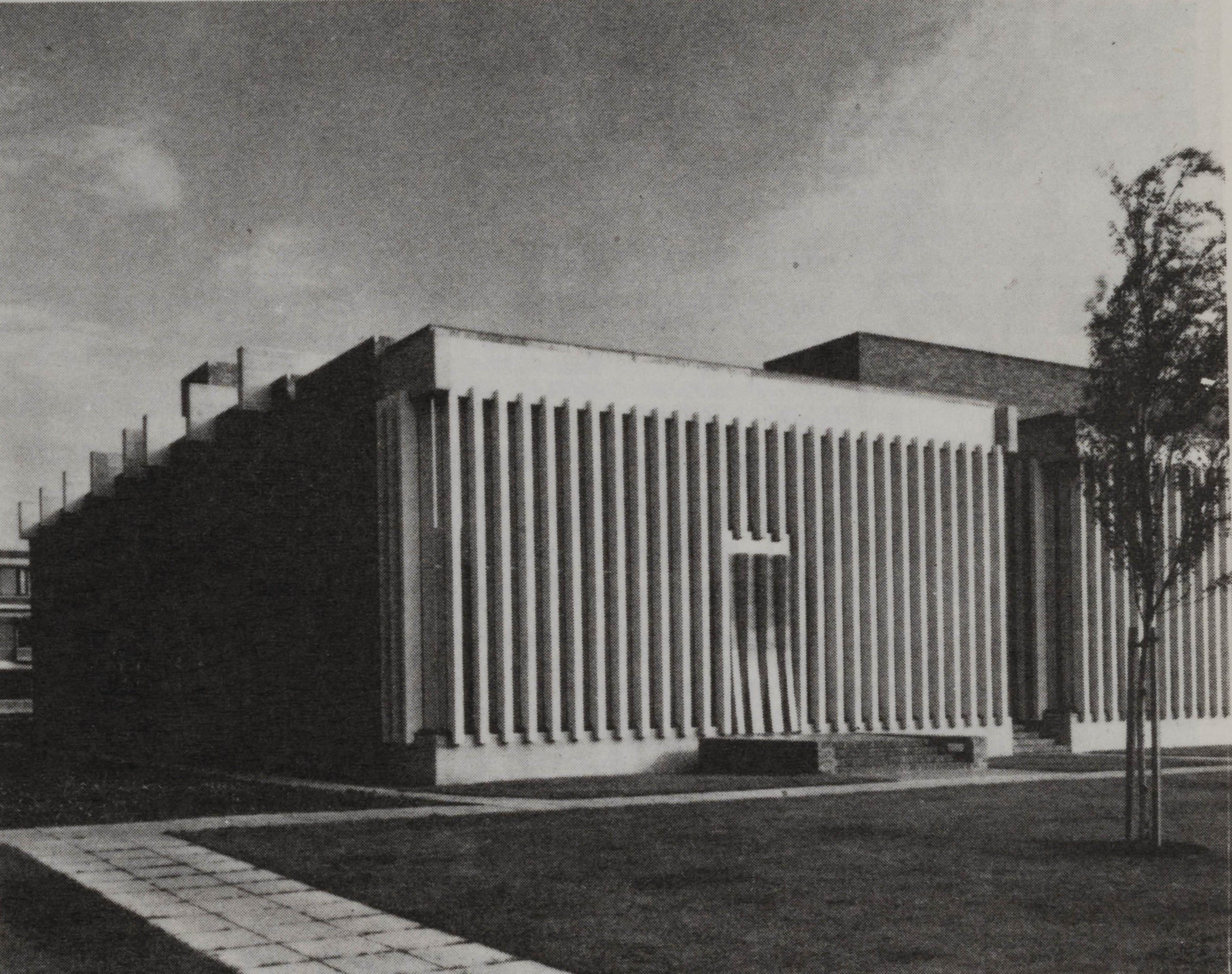
Inside Churchill Archives Centre
Reading Room
When it was opened in 1973, our reading room was initially made up of two air-conditioned rooms. One of the rooms was put aside for readers who were using typewriters and dictaphones, so that they wouldn’t disturb the other researchers. The Reading Room also hosted the treasures of Stephen Roskill’s library, leading the Archives Centre to name its book collection, the ‘Roskill Library’. In 2002 and 2019, we decided to make the Reading Room larger so that it could accommodate new readers. As we found fewer and fewer people used microfiche readers, we removed this room and created more desk space, which is how you’ll find the Reading Room today.
The reading room in 1978, CCAR/907/5.
Archivist Pat Ackerman sat at the reading room desk, Pat Ackerman personal collection.
The main desk in our Reading Room, with the old microfiche room to the left, before the refurbishment in November 2019, CCPH 5/8/4.
Readers in the reading room in 1983, CCAR/907/5.
Readers in our Reading Room c.1980-90s, CCAR/907/5.
Our Reading Room in March 2020 after the refurbishment, CCPH 5/8/4.
Strong Room

An Archives Assistant operating the hydraulic shelving in 1978, CCAR/907/5.
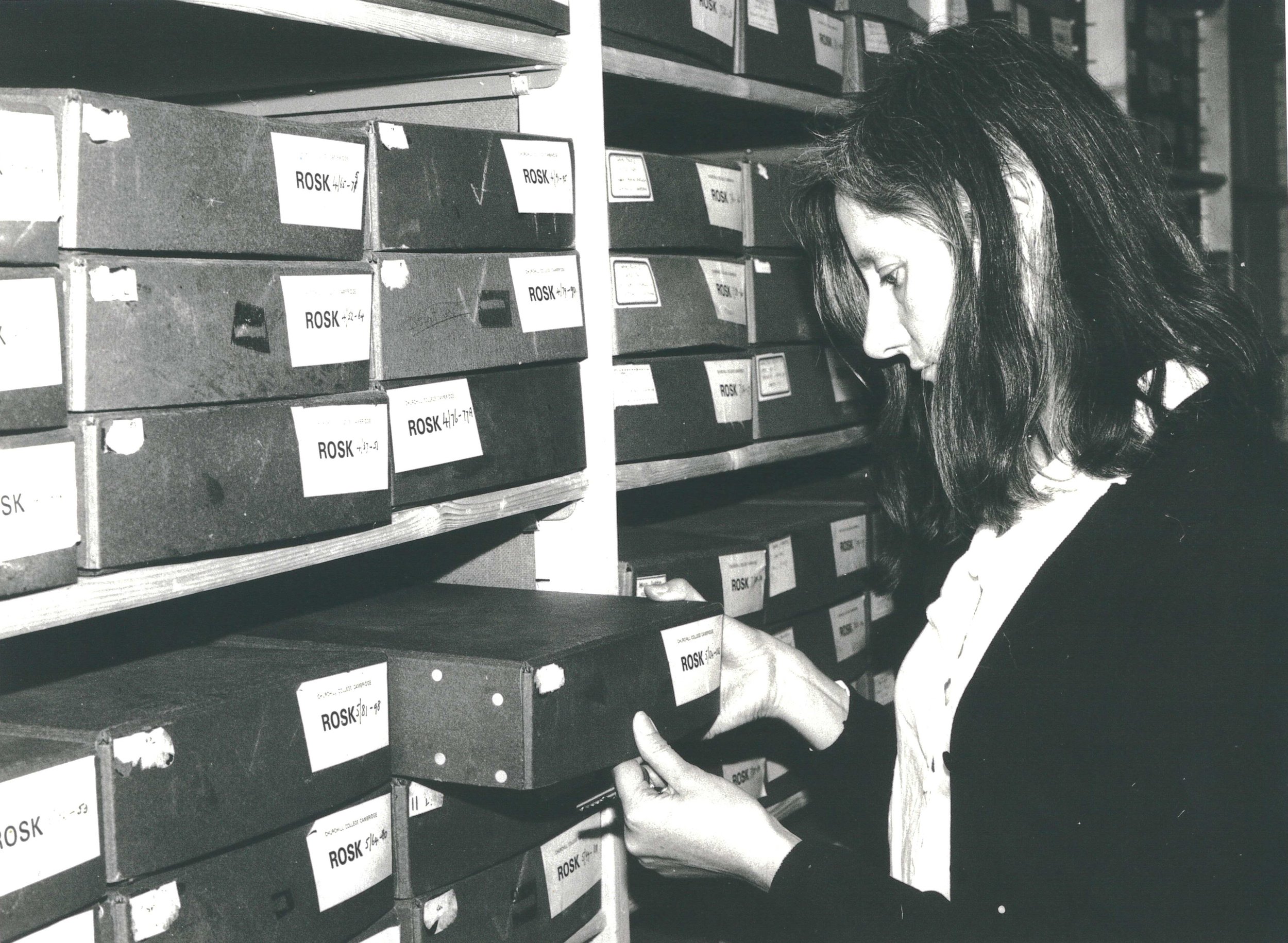
Archivist Pat Ackerman retrieving boxes from the Strong Room in the late-1970s, Pat Ackerman personal collection.

Search Room Assistant Monica Halpern retrieving boxes from the Strong Room in the early 1990s, CCAR/907/5.

Archives Assistant Martin Taylor in the Strong Room in the 1990s, Churchill Archives Centre box 45.
One of the most important parts of the new Archives Centre was the Strong Room, fitted with 31 bays designed to hold 315 boxes. In order to access one of these boxes, members of staff needed to operate our newly-built hydraulically powered shelves.
In the short interview below, Clare Brown, the Archive Centre’s second Archives Assistant, remembers the system which members of the Archives Team devised to ensure that no member of staff was caught between the stacks.
In 1995, after decades of use, the Wolfson Foundation partly funded the cost of installing manually-operated shelves, which we still use to this day.
‘Most of our readers are quite docile creatures, but there are occasional difficult characters in the search room area. You […] are the person in charge and the archivist will back you up.’
Lesley Akeroyd (née James) joined the Archives Centre team in 1986. In this interview, Lesley shares the document which she used as a guide when supervising readers in the Reading Room.
Sorting Room
Downstairs, the new Archives Centre hosted a sorting room - a place where collections could be stored while they were in the process of being catalogued. It was in this room that new collections were delivered, sorted, boxed, and catalogued. Archivists would then move the boxes upstairs to the main strong room ready for readers to consult.
In 2019, we renovated our sorting room and turned it into our reprographics room, so that we could provide more digital content to our readers. For those who are familiar with our free copying service - this is where the magic happens! We also gave ourselves a brand new sorting room with more shelving space to host our growing number of accessions, which in 2024 amounted to over 500.
A photograph of Marion Stewart, Archivist from 1978-1987, in the Sorting Room in 1978, CCAR 907/5.
The Sorting Room in 2019 before the refurbishment, CCPH 5/8/4.
A photograph of our Sorting Room in 1983, published in a brochure promoting the Archives in 1994. Members of staff from left to right are Kathryn Beckett (Assistant Archivist, 1992-4), Monica Halpern (Assistant Archivist, 1994-5), and Josephine Sykes (Secretary, 1991-1995). CCAR/907/5.
A photograph of the old Sorting Room turned into our new Reprographics Room following a refurbishment in 2019-20, CCPH 5/8/4.
Conservation Workshop

Photographs of Vic Brown at work, CCAR 907/5 pt 1.
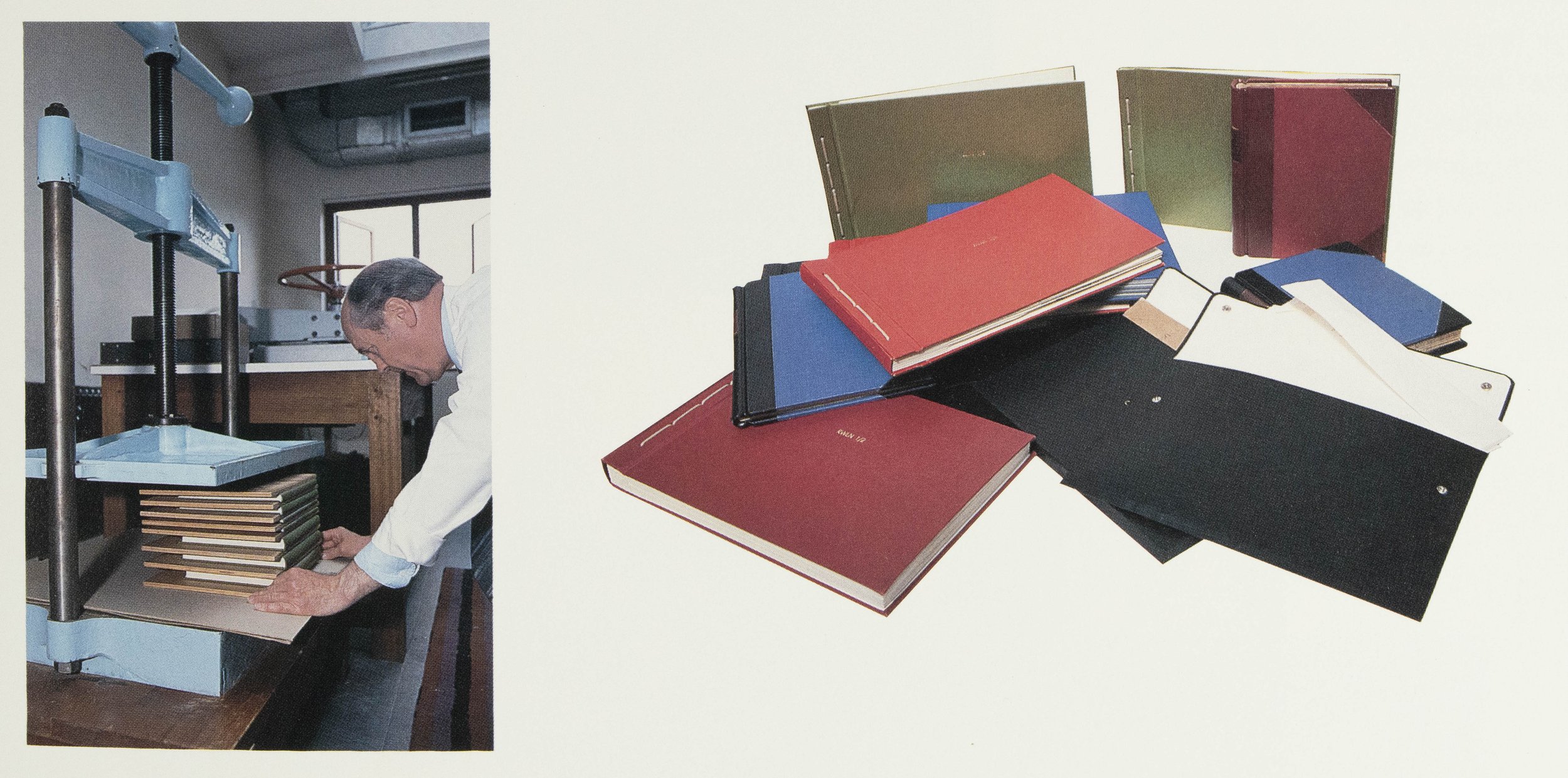
Photographs of Vic Brown at work, CCAR 907/5 pt 1.

Photographs of Vic Brown at work, CCAR 907/5 pt 1.
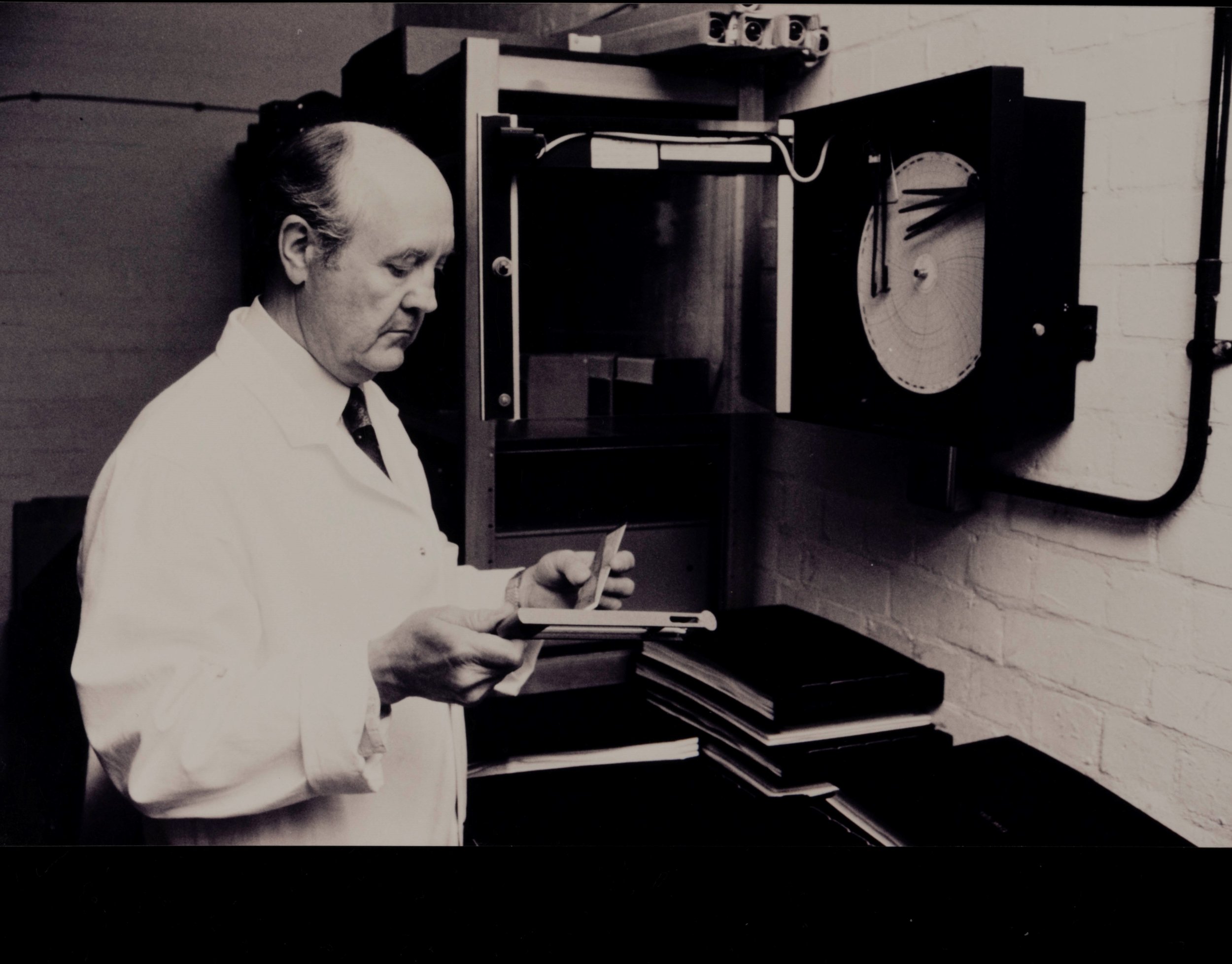
Victor Brown Personal Collection.
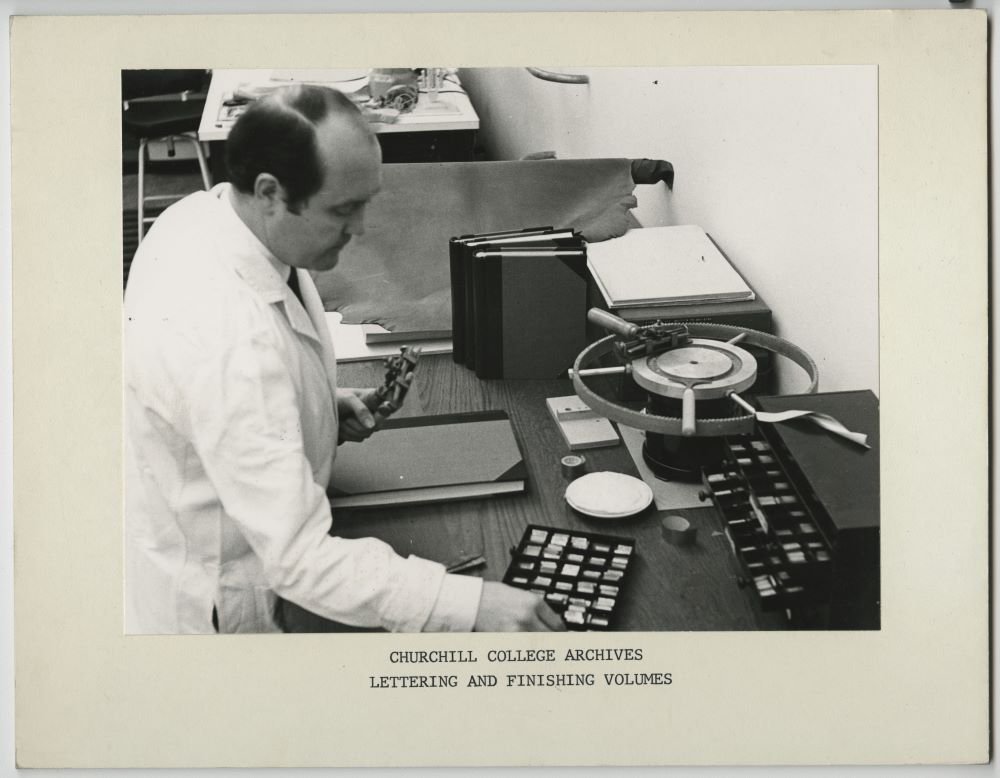
Vic Brown adding lettering to the front of a volume, CCAR 999/2.
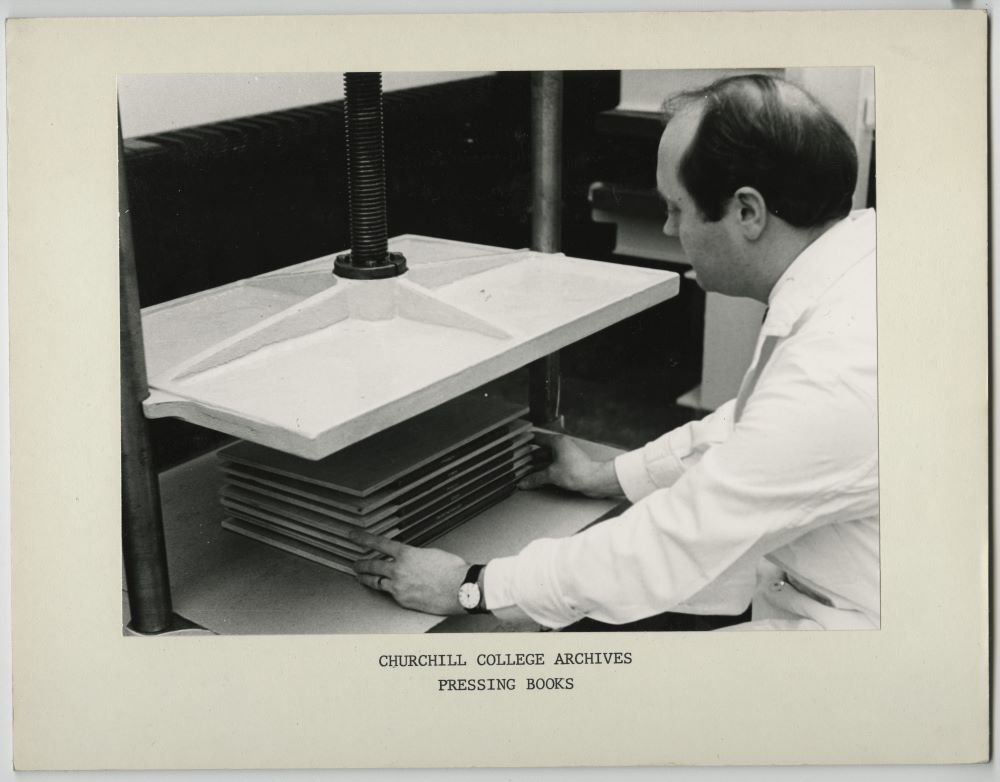
Vic Brown pressing books, CCAR 999/2.
The final part of our new building was the conservation workshop, measuring 45 by 12 feet. This was where Vic Brown (conservationist) and the Archive Centre’s first archivist, Edwin Welch worked. Here’s how one of our brochures described what some of Vic’s work entailed:
‘Twentieth-century papers, being often of poor quality (especially in the case of office flimsies or telegrams), receive very careful treatment before they are issued for handling by researchers: firstly, cleaning and de-acidifying; then laminating to protect and preserve them, followed by mounting on special guards for easy consultation and finally binding into volumes between hard covers.’
The skills Vic brought to the Archives Centre were deeply rooted in bookbinding. Most of the 20th century papers at the Archives Centre consisted of loose papers and Vic began a programme of binding (‘guarding and filing’) these papers. This was an approach advised and overseen by the Public Record Office, though Vic perfected it. This consisted of attaching the original papers to a new paper ‘guard’ using polyvinyl acetate (PVA) glue. Sometimes he would attach documents using strips of heat-set tissue (a Western tissue coated with acrylic adhesives activated by heat). The guards were then bound together into a loose-leaf binding consisting of gold-tooled library buckram covered boards and linen cord.
In an extract from an oral history interview with Vic, he describes what it was like to work with some of this historical material.
Like in other parts of the Archives Centre, we’ve modernised our conservation studio since it was built. We updated our equipment, adding a fume cupboard, polyester welding machine, humidifier and tacking iron amongst other things. Changing conservation techniques led us to buy more materials such as Japanese conservation papers, archival box boards, polyester packing and padding materials and new adhesives. In 2002, we refurbished the conservation studio to include two built-in light boxes, a large sink, drying racks, roll storage and inset equipment.
Image left: On the left, Vic Brown in the conservation studio in the 1970s. On the right, the conservation studio as it is today. Notice the addition of the lift in the far left hand side of the room.
“All the talents”:
The Churchill Archives Centre Team
Unlike today, when the Archives Centre was opened the team was very small. The team was made up of an archivist, archives assistant, and conservator, Vic. Initially, the team was headed up by Stephen Roskill, supported by a secretary.
Clare, who we’ve met already, was the Archive Centre’s second archives assistant, joining the team in 1978. In this short video, Clare remembers what it was like working with Stephen Roskill and the value he placed on each member of staff in the smooth running of the Archives Centre.
Pat Ackerman (née Bradford) joined the Archives Centre team in the late-1970s as an archivist. Pat worked closely with the Archive Centre’s new Keeper and historian Correlli ‘Bill’ Barnett and played an important part in acquiring collections. Pat later returned to the Archives Centre to run the college’s oral history programme from 1985-6 and again as an archivist in September 1990 when the Keeper of Archives was on leave.
Setting up the College archives
The archive of Churchill College had been steadily growing since the foundation of the College, predating the Archives Centre itself. It includes material on all aspects of College life – students’ academic and social lives, departmental work, staff, Fellows, and our estate. Departments systematically deposit material into the archive but the collection of material on students, staff and Fellows relies entirely on deposits from individuals and College societies.
During her time as an Archives Assistant, Lesley Akeroyd (née James) set up the college archive in 1988. This came on the back of a paper prepared by Keeper Bill Barnett and Fellow Mark Goldie. In this short interview, Lesley reflects on the process of setting up the college archive. In 1992, the college employed a part-time archivist, Joan Bullock-Anderson, to work specifically on the college archive.
From Keeper to Director
-
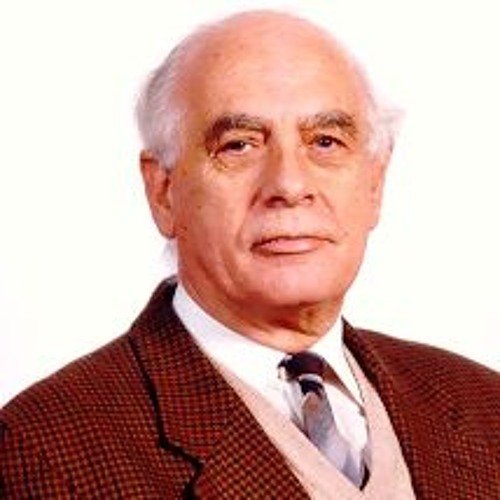
Michael Hoskin
LIBRARIAN AND KEEPER OF THE ARCHIVES (1969-1973)
-

Correlli 'Bill' Barnett
KEEPER OF THE ARCHIVES (1977-1995)
-

Piers Brendon
KEEPER OF THE ARCHIVES (1995-2002)
-

Allen Packwood
DIRECTOR (2002-present)
With its new building and room to expand, it made sense to formally separate the role of keeper from that of Librarian. The first holder of the new office was the military and industrial historian Bill Barnett. He took up his responsibilities on New Year’s Day 1977, little knowing that he would remain in office for the next eighteen years. In this time, the Archives Centre witnessed a large and sustained expansion of staff, public services and collections.
The Keeper’s leadership role was initially seen as a part-time job, well-suited for historians. Dr Piers Brendon, Keeper from 1995 to 2002, remembers how:
‘When Bill Barnett was due to retire as Keeper of the Churchill Archives Centre, I was encouraged to apply for the post on the grounds that it was “the finest sinecure in Cambridge”. The salary was small but so was the commitment: three days a week (affording me ample time to write) as titular head of a tiny organisation so starved of resources that it could do little more than tick over.’
In the 1990s, the college decided to change the title of ‘Keeper’ to ‘Director’ as it transitioned from a part-time to a full-time role. After joining the team as Archivist/ Exhibitions Officer in 1995, Allen Packwood became Director in 2002.

1995 - The Arrival of the
Churchill Papers
Since 1988, the Archives Centre had been negotiating with the government and the Churchill family trust about securing the papers of Winston Churchill. The Centre invited inspection by the Cabinet Secretary and the National Heritage Memorial Fund, and was validated as ‘in every respect a worthy permanent repository’ for the Chartwell Papers (Churchill’s pre-1945 papers) once a settlement had been reached.
Though the papers had been arriving in tranches since 1974, in 1995 the papers were bought for the Nation from the Chartwell Trust for £12.5 million. A further £1.75 million covered the cost of cataloguing, conservation and endowment here at the Archives Centre. £13.25 million of this funding came from the newly established Heritage Lottery Fund. Piers remembers how the Archives Centre was suddenly front page news:
‘Its announcement caused a furore. But, as we pointed out […] there is no doubt that the grant was well spent. All the Churchill Papers (including the post-1945 Papers, which Clementine Churchill had given to the College and which it contributed as “matching funding”) remained together in the building that was designed to hold them.’
Averil Condren was one of our longest-serving volunteers, joining the Archives in the mid-1990s to catalogue collections besides those relating to the Churchill family. In the video below, Averil reflects on how the Centre’s sense of purpose changed following the acquisition of the Churchill papers.
‘There was a much greater sense of purpose. People felt that they were part of something that mattered, something that was important. It wasn't just, oh, well, it's just the archives. It was “it's the archives”.’
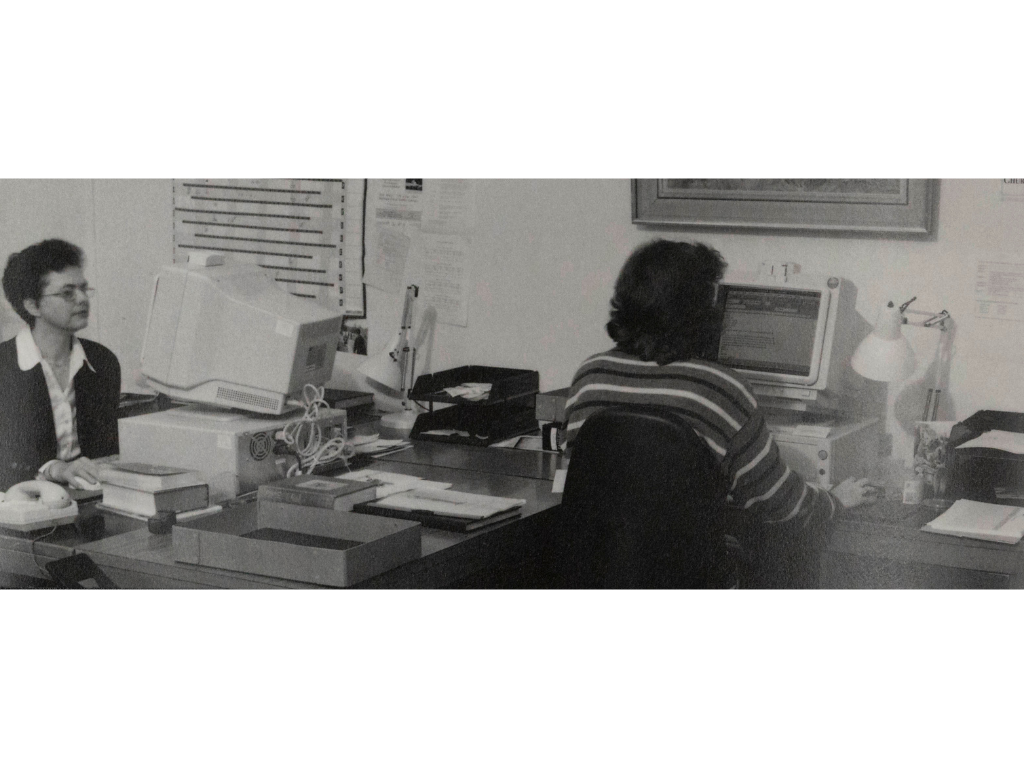
2001 - First Online Catalogue
In 2001, we published the catalogue for the Churchill Papers online for the first time. You can see what our catalogue looked like in the screen capture taken by the WayBack machine in 2002. After this, we began publishing online catalogues for other collections.
Image: A screen capture of the first online catalogue for the Churchill papers taken from the WayBack machine.

2002 - The Opening of the New Wing
In the early-1990s, Bill Barnett met informally with Denis Thatcher, where they discussed the long term home for the papers of Baroness Margaret Thatcher, Britain’s first female Prime Minister of the United Kingdom and longest serving Prime Minister of the twentieth century. By 1997, the papers had arrived.
The arrival of the Thatcher collection, coming fast upon the acquisition of other sizeable collections, took the existing Archives Centre strongroom to capacity, meaning that we needed a new building.
Sir Denis Thatcher visited the College on 19 July 2001 and formally cut the turf for the new wing of the Churchill Archives Centre. Construction commenced in August 2001 and finished in June 2002. It was opened by Baroness Thatcher on 30 October 2002.
Designed by Cambridge architects Thurlow, Curtis and Carnell, the building comprises four storeys of secure archival storage. The New Wing provides the permanent home for the Thatcher papers and trebled the capacity of the Archives Centre.
Image: Three promotional brochures for the New Wing of Churchill Archives Centre, Churchill Archives Centre Box 45.
‘Politicians' private papers offer insights which could not be gained from any other source. The material contained in the Churchill Archives is a real national asset, which I hope that generations of researchers will quarry to good effect.’
Baroness Margaret Thatcher
Photographs below: various shots of the exterior and interior of the New Wing.


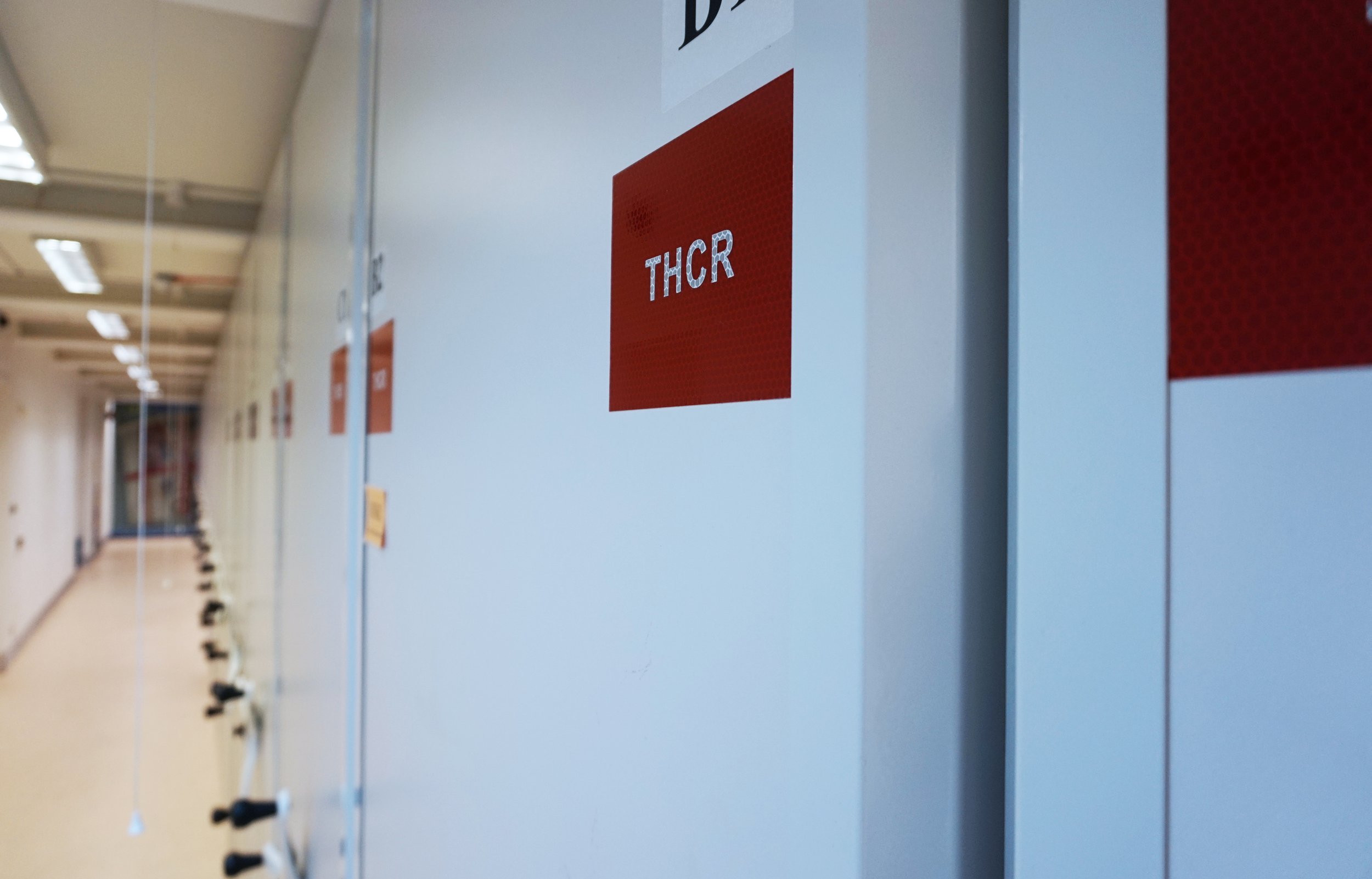



2015
Archives Centre Accreditation
Accreditation was the next big step on the Archive Centre’s journey. Accreditation is the UK quality standard and achieving accredited status demonstrates that Churchill Archives Centre has met clearly defined national standards. After looking around the Centre, the Accreditation Panel said:
‘This was a very impressive application all round. […] The collections and the Centre are demonstrably an asset to the college and to the university.’
2012
In 2012, we launched the digital library, The Churchill Archive, which shares more than 800,000 pages of original documents from the papers of Winston Churchill produced between 1874 and 1965. These are used to support teaching, study and research. Documents range from Winston Churchill’s personal correspondence to exchanges between leaders in the nineteenth and twentieth centuries.
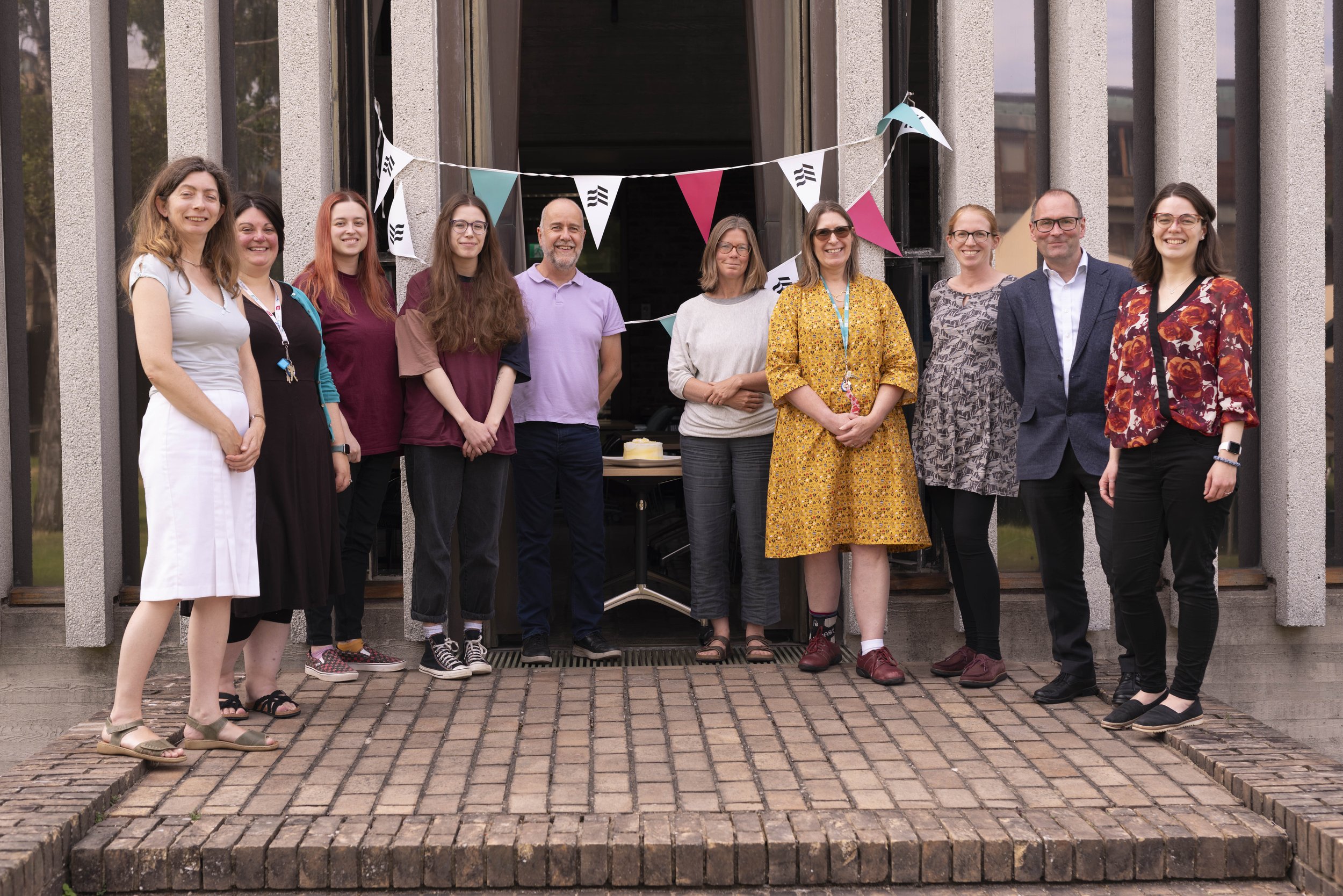
The Archives Centre at 50
In our 50th year, we’ve marked our special anniversary with a range of initiatives, including:
a two-day conference, where some of our earliest researchers met some of our recent academic friends and By-Fellows
the launch of our new digital Access Portal, making it possible for researchers to access some of our collections anywhere in the world
the creation of our 50 stories for 50 years social media series, designed to spotlight the stories told by our researchers, staff, and volunteers about their experiences at the Archives Centre.
Acknowledgements
We would like to say a huge thank you to everyone who has shared in our celebrations over the last twelve months, as well as the many members of the Churchill Archives Team who have contributed to this 50th Anniversary exhibition.
A special thank you to:
Paula Laycock, College and Records Officer for curating extracts from the college’s oral history archive
Clare Brown, Lesley Ackeroyd, Pat Ackerman, and Averil Condren for their video contributions to our ‘50 stories for 50 years’ series
Research conducted on the history of Churchill Archives Centre by Sophie Bridges and Prof Mark Goldie
Picture credits: Pat Ackerman, Victor Brown, the BBC, and Lafayette Photography Ltd.


